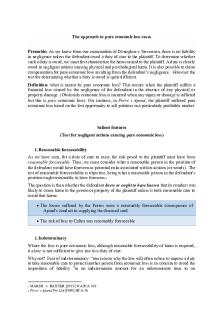Salient features - 1234 PDF

| Title | Salient features - 1234 |
|---|---|
| Author | Murtaza Yusufi |
| Course | Advanced engineering mathematics |
| Institution | Monash University |
| Pages | 4 |
| File Size | 240 KB |
| File Type | |
| Total Downloads | 25 |
| Total Views | 171 |
Summary
1234...
Description
The approach to pure economic loss cases Preamble: As we know from our examination of Donoghue v Stevenson, there is no liability in negligence unless the defendant owed a duty of care to the plaintiff. To determine whether such a duty is owed, we must first characterize the harm caused to the plaintiff. A duty is clearly owed in negligent actions causing physical and psychological harm. It is also possible to claim compensation for pure economic loss resulting from the defendant’s negligence. However the test for determining whether a duty is owed is quite different. Definition: what is meant by pure economic loss? This occurs when the plaintiff suffers a financial loss caused by the negligence of the defendant in the absence of any physical or property damage. (Obviously economic loss is incurred when any injury or damage is inflicted but this is pure economic loss). For instance, in Perre v Apand, the plaintiff suffered pure economic loss based on the lost opportunity to sell potatoes in a particularly profitable market.
Salient features (Test for negligent actions causing pure economic loss) 1. Reasonable foreseeability As we have seen, for a duty of care to exist, the risk posed to the plaintiff must have been reasonably foreseeable. Thus, we must consider what a reasonable person in the position of the defendant would have foreseen as potential risks associated with its actions (or words). The test of reasonable foreseeability is objective, being what a reasonable person in the defendant's position ought reasonably to have foreseen.1 The question is then whether the defendant knew or ought to have known that its conduct was likely to cause harm to the person or property of the plaintiff unless it took reasonable care to avoid that harm2. • The losses suffered by the Perres were a reasonably foreseeable consequence of Apand's conduct in supplying the diseased seed • The risk of loss to Caltex was reasonably foreseeable
2. Indeterminacy Where the loss is pure economic loss, although reasonable foreseeability of harm is required, it alone is not sufficient to give rise to a duty of care. Why not? Fear of indeterminancy: “one reason why the law will often refuse to impose a duty to take reasonable care to protect another person from economic loss is its concern to avoid the imposition of liability "in an indeterminate amount for an indeterminate time to an
1 2
MARSH -v- BAXTER [2015] WASCA 169 Perre v Apand Pty Ltd [1999] HCA 36
indeterminate class"3. In this regard, to apply a duty of care for mere foreseeability that a person might suffer a financial loss would extend liability in negligence beyond acceptable bounds and could stifle commercial activity. However, it is not the size or number of claims that is decisive in determining whether potential liability is so indeterminate that no duty of care is owed4. Liability is indeterminate only when it cannot be realistically calculated.5 • The Perres were members of a class whose members, whether numerous or not, were ascertainable by Apand; • Imposing the duty on Apand did not expose it to indeterminate liability although its liability may be large; • Whether or not Apand knew who were the members of the class is beside the point. • In Caltex no question of indeterminate liability arose;
3. Individual autonomy factor: Unreasonable Burdens on the Autonomy of Individuals The common law, reflecting the society at large, regards individuals as free and autonomous, able to make their own choices and as having no overriding responsibility for the welfare of others. Thus, provided that a person is legitimately protecting or developing or expanding their commercial interests, the law will not require that that person to be concerned with the effect of their conduct on the economic well-being of others. What is considered a legitimate pursuit of a commercial interest? Competitive acts (eg Coles opens a supermarket next to a corner grocery store that has been there since the First Fleet arrived) are legitimate. Another example is the case of a consumer who owes no duty to a trader not to cause loss by withdrawing custom. However, where other indications (signs) of duty are present, this immunity cannot extend to conduct which cannot be fairly described as a legitimate pursuit or protection of a person's interests.6 It is commonplace in the law of negligence that defendants are required to modify their otherwise lawful conduct in response to the foreseeable risk of harm to another person. The principle of commercial or business autonomy is not absolute, even in cases of pure economic loss.7 • Imposing a duty did not unreasonably interfere with Apand's commercial freedom because it was already under a duty to take reasonable care; • In Caltex, In Caltex, the defendant's freedom of action was not impaired by imposing a duty because it already owed a duty to the owner of the pipelines;
Ultramares Corporation v Touche 174 NE 441 at 444 (1931) per Cardozo CJ. Canadian National Railway Co v Norsk Pacific Steamship Co [1992] 1 SCR 1021 at 1105 per La Forest J. 5 Perre v Apand Pty Ltd [1999] HCA 36 6 Perre v Apand Pty Ltd [1999] HCA 36 7 MARSH -v- BAXTER [2015] WASCA 169 3 4
4. Vulnerability In recent cases, such as Perre v Apand, the Court has required an element of vulnerability in order to establish a duty of care. Vulnerability is characterised as the inability of the plaintiff’s to take steps to protect itself from the consequences of a defendant’s conduct. By contrast, if it was reasonably open to the plaintiff to take steps to protect itself, then there will no sound reason for imposing a duty8. In Perre v Apand the plaintiff was not in a position to do anything to protect itself from the economic consequences of the defendant’s negligence in sowing a crop. However, in Esanda v Peat Marwick Hungerfords, Esanda could have made its own enquiries about the financial position of the company to which it was to lend money (and not simply rely on the auditor’s certification of the accounts of the company). Factors which may determine the degree of vulnerability of the plaintiff are: • Physical proximity between the plaintiff and the defendant • Whether the risk is in direct and sole control of the defendant • The the Perres' business was vulnerably exposed to Apand's conduct because the Perres were not in a position to protect themselves against the effects of Apand's negligence • Apand had control over the actions causing harm. • Ignorant of the danger, the Perres were not in a position to do anything that could protect their economic interests • In Caltex, Caltex could not readily avoid the risk of incurring the relevant expenses;
5. The defendant’s knowledge of the risk and its magnitude To impose a duty of care, the likelihood in succeeding is much greater if the defendant actually knew (or ought to have known) of the risk and its magnitude. In Perre the High Court decided that Apand was (or should have been) aware of the risk and its magnitude. • They were likely to suffer loss of great magnitude if the Sparnons' property was infected with bacterial wilt as a result of its negligence, as Apand well knew. • It is indisputable that growers within the class, such as the Perres, were at great risk as the result of the supply of the seed. • In Caltex the defendant "must be taken to have known that carelessness in those operations, causing injury to the pipelines, would affect Caltex in precisely the way it did" 9.
Perre v Apand Pty Ltd [1999] HCA 36 Caltex Oil (Australia) Pty Ltd v The Dredge “Willemstad” (1976) 136 CLR 529 at 578 per Stephen J.
8 9
1. Was the loss suffered by the plaintiff reasonably foreseeable? 2. If yes to question 1, would the imposition of a duty of care impose indeterminate liability on the defendant? 3. If no to question 2, would the imposition of a duty of care impose an unreasonable burden on the autonomy of the defendant? 4. If no to question 3, was the plaintiff vulnerable to loss from the conduct of the defendant?
5. Did the defendant know that its conduct could cause harm to individuals such as the plaintiff?...
Similar Free PDFs

Salient features - 1234
- 4 Pages

Salient Features of 80286
- 13 Pages

Q salient features Australia
- 3 Pages

exercícios 1234
- 2 Pages

Sedimentary Features
- 1 Pages

Design Features
- 9 Pages

Anamnesis Final - Apuntes 1234
- 9 Pages

Tcs report 1234
- 22 Pages

29 vector algebra 1234
- 17 Pages

Research poem 1234
- 1 Pages

Archivo de ejercicios 1234
- 7 Pages
Popular Institutions
- Tinajero National High School - Annex
- Politeknik Caltex Riau
- Yokohama City University
- SGT University
- University of Al-Qadisiyah
- Divine Word College of Vigan
- Techniek College Rotterdam
- Universidade de Santiago
- Universiti Teknologi MARA Cawangan Johor Kampus Pasir Gudang
- Poltekkes Kemenkes Yogyakarta
- Baguio City National High School
- Colegio san marcos
- preparatoria uno
- Centro de Bachillerato Tecnológico Industrial y de Servicios No. 107
- Dalian Maritime University
- Quang Trung Secondary School
- Colegio Tecnológico en Informática
- Corporación Regional de Educación Superior
- Grupo CEDVA
- Dar Al Uloom University
- Centro de Estudios Preuniversitarios de la Universidad Nacional de Ingeniería
- 上智大学
- Aakash International School, Nuna Majara
- San Felipe Neri Catholic School
- Kang Chiao International School - New Taipei City
- Misamis Occidental National High School
- Institución Educativa Escuela Normal Juan Ladrilleros
- Kolehiyo ng Pantukan
- Batanes State College
- Instituto Continental
- Sekolah Menengah Kejuruan Kesehatan Kaltara (Tarakan)
- Colegio de La Inmaculada Concepcion - Cebu




